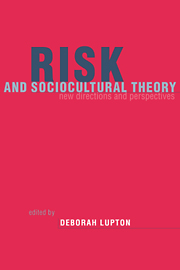Book contents
- Frontmatter
- Contents
- List of contributors
- Introduction: risk and sociocultural theory
- 1 Postmodern reflections on ‘risk’, ‘hazards’ and life choices
- 2 Fear of crime and the media: sociocultural theories of risk
- 3 Risk and the ontology of pregnant embodiment
- 4 Risk anxiety and the social construction of childhood
- 5 Constructing an endangered nation: risk, race and rationality in Australia's native title debate
- 6 Risk, calculable and incalculable
- 7 Ordering risks
- Index
Introduction: risk and sociocultural theory
Published online by Cambridge University Press: 16 September 2009
- Frontmatter
- Contents
- List of contributors
- Introduction: risk and sociocultural theory
- 1 Postmodern reflections on ‘risk’, ‘hazards’ and life choices
- 2 Fear of crime and the media: sociocultural theories of risk
- 3 Risk and the ontology of pregnant embodiment
- 4 Risk anxiety and the social construction of childhood
- 5 Constructing an endangered nation: risk, race and rationality in Australia's native title debate
- 6 Risk, calculable and incalculable
- 7 Ordering risks
- Index
Summary
One of the most lively areas of theoretical debate in social and cultural theory in recent times is that addressing the phenomenon of risk and the role it plays in contemporary social life and subjectivities. Three major theoretical perspectives on risk emerging since the early 1980s and gaining momentum in the 1990s may be distinguished. The first is offered by the work of Mary Douglas, who began in the early 1980s setting forth an influential perspective on risk, one that adopts a cultural anthropological approach (Douglas and Wildavsky, 1982; Douglas, 1985, 1990, 1992). The German sociologist Ulrich Beck's book Risk Society, published in English in 1992, has provided a major impetus to recent sociological examination of risk (for some of his other writings on risk in English see also Beck, 1992a, 1992b, 1994, 1995, 1996a, 1996b; Beck and Gernsheim, 1995). The English sociologist Anthony Giddens (1990, 1991, 1994, 1998), adopting a similar perspective to that of Beck, has also influenced sociological diagnoses of the role of risk in society. A third perspective is offered by the several theorists who have taken up Michel Foucault's writings on governmentality (for example, Foucault, 1991) to explore the ways in which the state and other governmental apparatuses work together to govern – that is, manage and regulate – populations via risk discourses and strategies (Castel, 1991; Ewald, 1991; O'Malley, 1996; Dean, 1997).
I have elsewhere identified these three major approaches respectively as the ‘cultural/symbolic’, the ‘risk society’ and the ‘governmentality’ perspectives (see Lupton, 1999).
- Type
- Chapter
- Information
- Risk and Sociocultural TheoryNew Directions and Perspectives, pp. 1 - 11Publisher: Cambridge University PressPrint publication year: 1999
- 69
- Cited by



